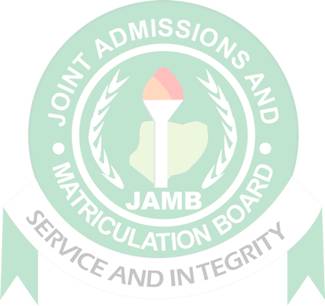
Chemistry
Paper 1 | Objectives | 45 Questions
JAMB Exam
Year: 1984
Level: SHS
Time:
Type: Question Paper
Answers provided
FREE
No description provided
Feedbacks
This paper is yet to be rated

Paper 1 | Objectives | 45 Questions
JAMB Exam
Year: 1984
Level: SHS
Time:
Type: Question Paper
Answers provided
No description provided
This paper is yet to be rated
Get free IT courses with certificates online for your skills upgrade in this era of Covid-19.
Effective ways of coping with exam stress and test anxiety which is supported by Science
Adequate preparation and effective revision strategies tips to get a high score 320 in JAMB in 2022
| # | Question | Ans |
|---|---|---|
| 1. |
Sodium chloride may be obtained from brine by A. titration B. decantation C. distillation D. evaporation E. sublimation |
D |
| 2. |
20 cm 3 of hydrogen gas are sparked with 20cm 3 of oxygen gas in an endimoeter at 373k (100 oC) and 1 atmosphere. The resulting mixture is cooled to 298 K (25 oC) and passed over calcium chloride. The volume of the residual gas is A. 40 cm 3 B. 20 cm 3 C. 30 cm 3 D. 10cm 3 E. 5cm 3
Show Content
Detailed Solution2H2 + O2 ------2H2O2V 1V 2V 20cm3 20cm3 ------- 20cm3 10cm3 20cm3 Residual gas = 20cm3 - 10cm3 of 02 = 103 |
|
| 3. |
For the reaction NH4NO2 \(\to\) N2 + 2H2O, calculate the volume of nitrogen that would be produced at S. T. P from 3.2 g of the dioxonitrate(iii)salt. (Relative atomic masses: N = 14, O = 16, H = 1) A. 2.24 dm 3 B. 2.24 cm3 C. 123 D. 12dm 3 E. 48 dm 3
Show Content
Detailed Solution\(NH_{4}NO_{2}\) \(\to\) \(N_{2}\) + \(2H_{2}O\)\(64g\) \(\to\) \(22.4dm^{3}\) \(3.2g\) will give \(\frac{22.4}{64}\) \(\times\) \(\frac{3.2}{64}\) = \(1.12dm^{3}\) |
|
| 4. |
A molar solution of caustic soda is prepared by dissolving A. 40 g NaOH in 100 g of water B. 40 g NaOH in 1000 g of water C. 20 g NaOH in 500 of solution D. 20 g NaOH in 1000 g of solution E. 2o g NaOH in 80 g of solution
Show Content
Detailed SolutionA molar solution implies concentration in terms of moles/liter. The respective atomic weights for NaOH are: Na - 23,0 - 16 and H - 1, so the molecular weight, is 23 + 16 + I = 40. Thus 40 grams of NaOH equals one mole of NaOH, and a 1 molar solution of NaOH will contain 40 grams of NaOH chemical in 1000grams of water. |
|
| 5. |
Which among the elements 1. Carbon 2. Oxygen 3. Copper 4. Bromine 5. Zinc, will NOT react with either water or steam? A. 1 and 2 B. 2 and 3 C. 3 and 4 D. 1, 2, and 3 E. 2, 3, and 5 |
B |
| 6. |
Naphthalene when heated melts at 354 K (81 oC). At this temperature the molecules of naphthalene A. decompose into smaller molecules B. change their shape C. are oxidized by atmospheric oxygen D. contract E. become mobile as the inter molecular forces are broken |
E |
| 7. |
The ratio of the number of molecules in 2g of hydrogen to that in 16g of oxygen is A. 2:1 B. 1:1 C. 1:2 D. 1:4 E. 1:8 |
A |
| 8. |
The balanced equation for the reaction of tetraoxosulphate(VI)acid with aluminium hydroxide to give water and aluminium tetraoxosulphate(VI) is A. H2SO4 + Al(OH)2 \(\to\) 2H2O + AlSO4 B. 3H2SO4 + 2Al(OH)3 \(\to\) 6H2O + Al2(SO4)3 C. 3H2SO4 + 2AlH \(\to\) 6H2O + Al(SO4)3 D. 3H2 SO4 + 2Al(OH)3 \(\to\) Al(SO4)3 E. H2SO4 + Al(OH)3 \(\to\) H2O + Al2(SO4)3 |
B |
| 9. |
Which of the following mixtures would result in a solution of pH greater than 7? A. 25.00 cm3 of 0.05 M H2SO4 and 25.00cm3 of 0.50 M Na2CO3 B. 25.00 cm3 of 0.05 M H2SO4 and 25.00 cm3 of 0.10 M NaHCO3 C. 10 M NaOH D. 25.00cm3 of 0.11 MH2 SO4 and 50.00 cm3 of 0.05 M NaOH E. 25.00cm3 of 0.25 M H2SO4 and 50.00cm3 of 0.20 M NaOH |
A |
Preview displays only 9 out of the 45 Questions